Gender Inequality in Business and Sports
VerifiedAdded on 2020/03/16
|14
|3960
|42
AI Summary
This document comprises a collection of academic research papers exploring various facets of gender inequality. Topics covered include the wage gap, organizational culture, representation in leadership roles, and discriminatory practices within industries like accounting and project management. The papers also delve into gender disparities in sports, highlighting unequal pay and media coverage for women athletes.
Contribute Materials
Your contribution can guide someone’s learning journey. Share your
documents today.

Managing across borders 1
MANAGING ACROSS BORDERS
Student Name
Course Title
Professor
Name of the Institution
City and State
Date
MANAGING ACROSS BORDERS
Student Name
Course Title
Professor
Name of the Institution
City and State
Date
Secure Best Marks with AI Grader
Need help grading? Try our AI Grader for instant feedback on your assignments.
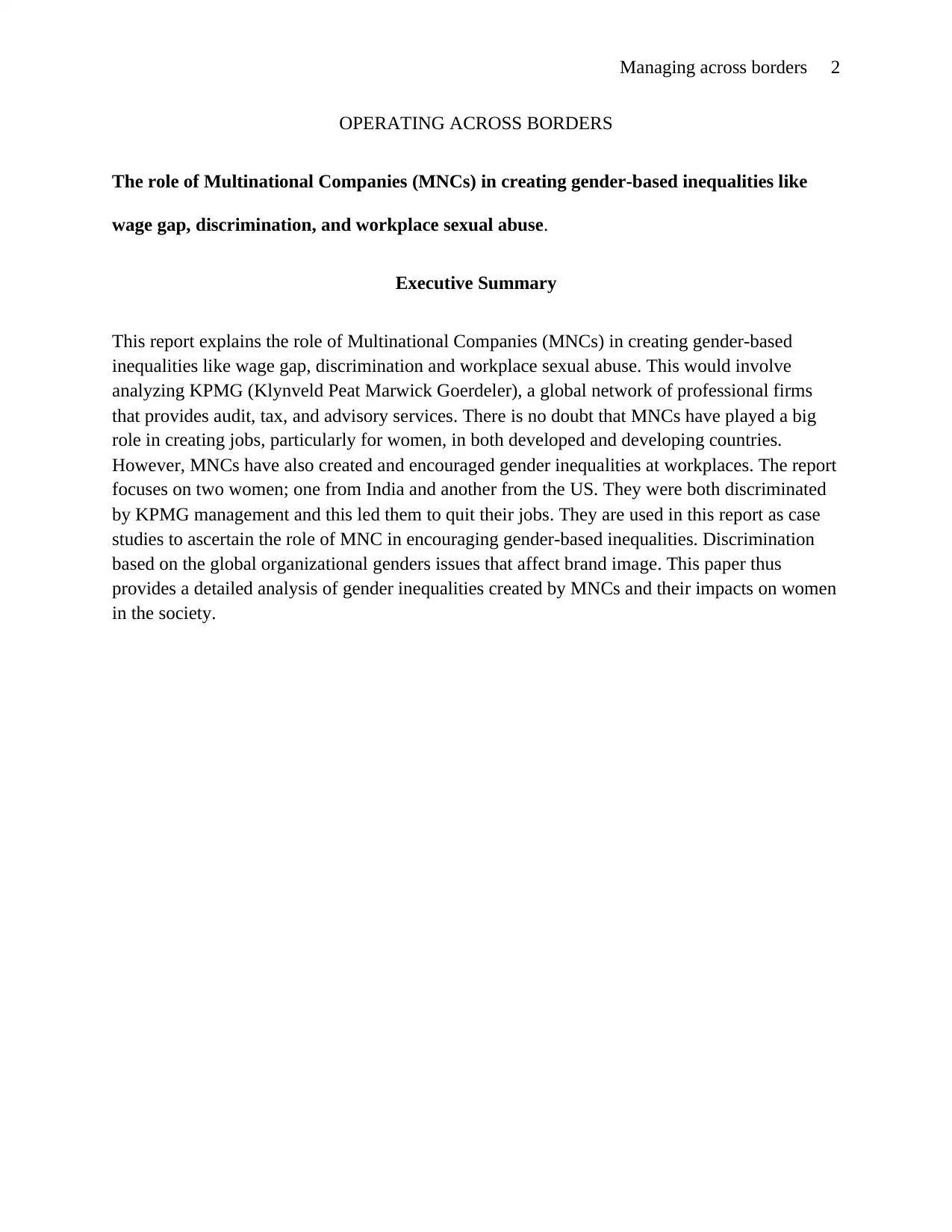
Managing across borders 2
OPERATING ACROSS BORDERS
The role of Multinational Companies (MNCs) in creating gender-based inequalities like
wage gap, discrimination, and workplace sexual abuse.
Executive Summary
This report explains the role of Multinational Companies (MNCs) in creating gender-based
inequalities like wage gap, discrimination and workplace sexual abuse. This would involve
analyzing KPMG (Klynveld Peat Marwick Goerdeler), a global network of professional firms
that provides audit, tax, and advisory services. There is no doubt that MNCs have played a big
role in creating jobs, particularly for women, in both developed and developing countries.
However, MNCs have also created and encouraged gender inequalities at workplaces. The report
focuses on two women; one from India and another from the US. They were both discriminated
by KPMG management and this led them to quit their jobs. They are used in this report as case
studies to ascertain the role of MNC in encouraging gender-based inequalities. Discrimination
based on the global organizational genders issues that affect brand image. This paper thus
provides a detailed analysis of gender inequalities created by MNCs and their impacts on women
in the society.
OPERATING ACROSS BORDERS
The role of Multinational Companies (MNCs) in creating gender-based inequalities like
wage gap, discrimination, and workplace sexual abuse.
Executive Summary
This report explains the role of Multinational Companies (MNCs) in creating gender-based
inequalities like wage gap, discrimination and workplace sexual abuse. This would involve
analyzing KPMG (Klynveld Peat Marwick Goerdeler), a global network of professional firms
that provides audit, tax, and advisory services. There is no doubt that MNCs have played a big
role in creating jobs, particularly for women, in both developed and developing countries.
However, MNCs have also created and encouraged gender inequalities at workplaces. The report
focuses on two women; one from India and another from the US. They were both discriminated
by KPMG management and this led them to quit their jobs. They are used in this report as case
studies to ascertain the role of MNC in encouraging gender-based inequalities. Discrimination
based on the global organizational genders issues that affect brand image. This paper thus
provides a detailed analysis of gender inequalities created by MNCs and their impacts on women
in the society.
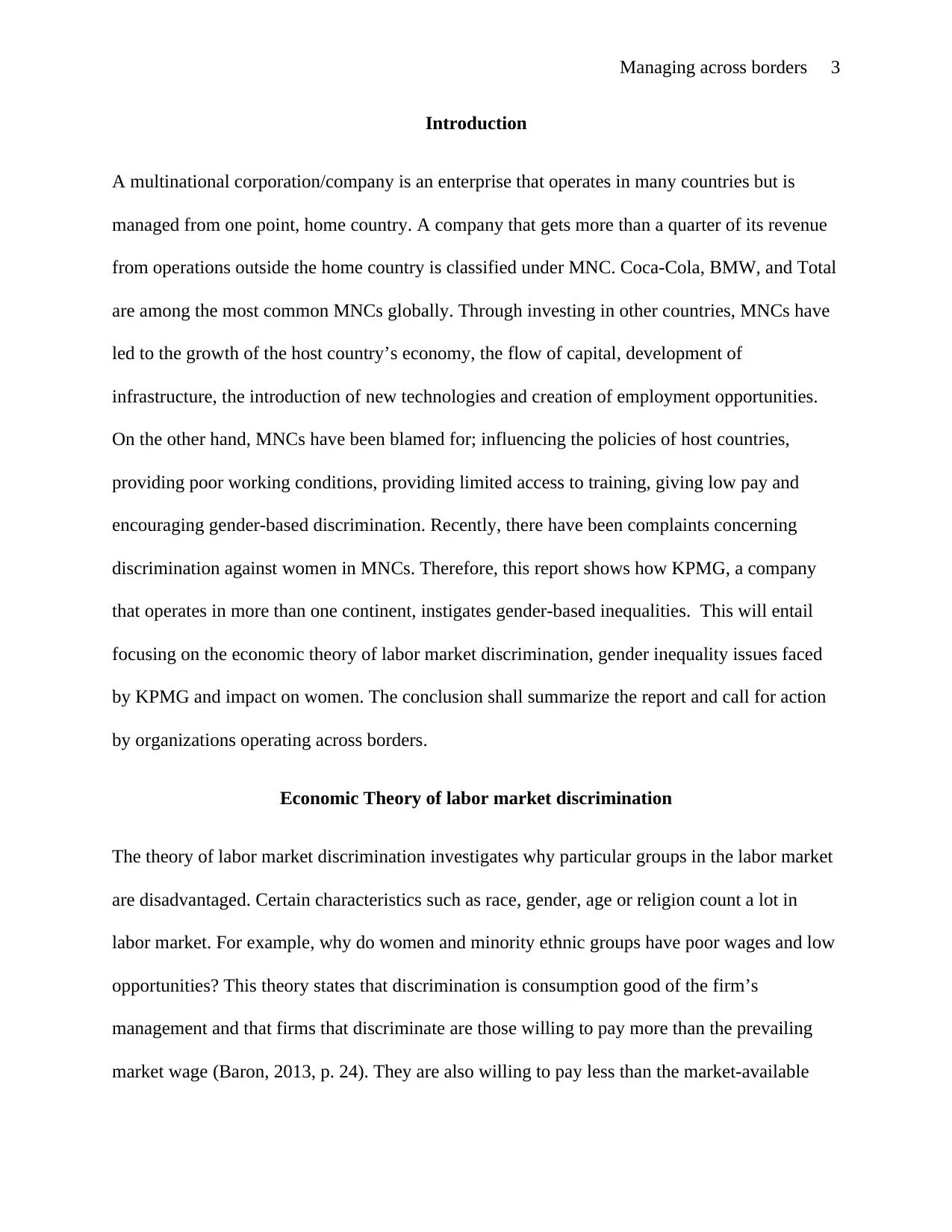
Managing across borders 3
Introduction
A multinational corporation/company is an enterprise that operates in many countries but is
managed from one point, home country. A company that gets more than a quarter of its revenue
from operations outside the home country is classified under MNC. Coca-Cola, BMW, and Total
are among the most common MNCs globally. Through investing in other countries, MNCs have
led to the growth of the host country’s economy, the flow of capital, development of
infrastructure, the introduction of new technologies and creation of employment opportunities.
On the other hand, MNCs have been blamed for; influencing the policies of host countries,
providing poor working conditions, providing limited access to training, giving low pay and
encouraging gender-based discrimination. Recently, there have been complaints concerning
discrimination against women in MNCs. Therefore, this report shows how KPMG, a company
that operates in more than one continent, instigates gender-based inequalities. This will entail
focusing on the economic theory of labor market discrimination, gender inequality issues faced
by KPMG and impact on women. The conclusion shall summarize the report and call for action
by organizations operating across borders.
Economic Theory of labor market discrimination
The theory of labor market discrimination investigates why particular groups in the labor market
are disadvantaged. Certain characteristics such as race, gender, age or religion count a lot in
labor market. For example, why do women and minority ethnic groups have poor wages and low
opportunities? This theory states that discrimination is consumption good of the firm’s
management and that firms that discriminate are those willing to pay more than the prevailing
market wage (Baron, 2013, p. 24). They are also willing to pay less than the market-available
Introduction
A multinational corporation/company is an enterprise that operates in many countries but is
managed from one point, home country. A company that gets more than a quarter of its revenue
from operations outside the home country is classified under MNC. Coca-Cola, BMW, and Total
are among the most common MNCs globally. Through investing in other countries, MNCs have
led to the growth of the host country’s economy, the flow of capital, development of
infrastructure, the introduction of new technologies and creation of employment opportunities.
On the other hand, MNCs have been blamed for; influencing the policies of host countries,
providing poor working conditions, providing limited access to training, giving low pay and
encouraging gender-based discrimination. Recently, there have been complaints concerning
discrimination against women in MNCs. Therefore, this report shows how KPMG, a company
that operates in more than one continent, instigates gender-based inequalities. This will entail
focusing on the economic theory of labor market discrimination, gender inequality issues faced
by KPMG and impact on women. The conclusion shall summarize the report and call for action
by organizations operating across borders.
Economic Theory of labor market discrimination
The theory of labor market discrimination investigates why particular groups in the labor market
are disadvantaged. Certain characteristics such as race, gender, age or religion count a lot in
labor market. For example, why do women and minority ethnic groups have poor wages and low
opportunities? This theory states that discrimination is consumption good of the firm’s
management and that firms that discriminate are those willing to pay more than the prevailing
market wage (Baron, 2013, p. 24). They are also willing to pay less than the market-available
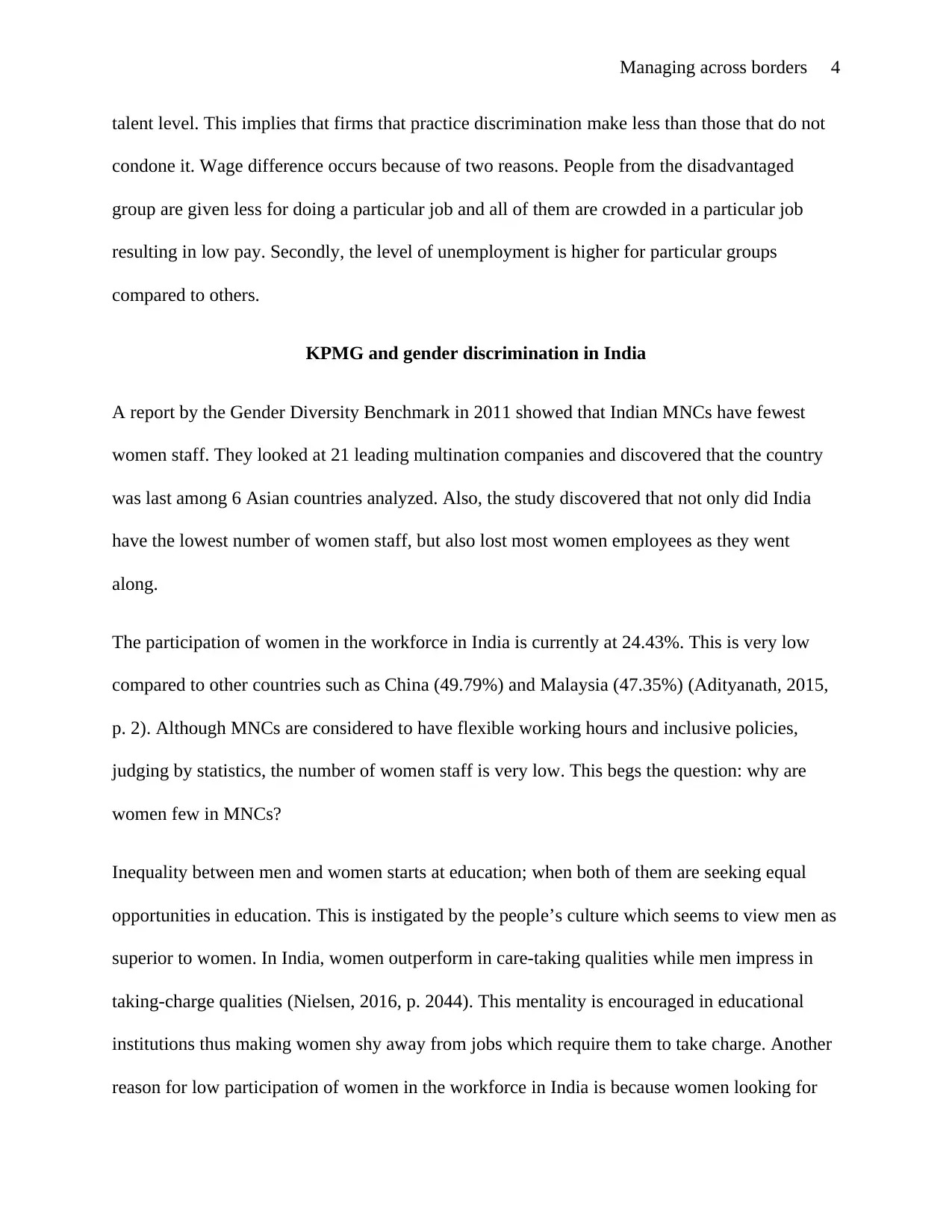
Managing across borders 4
talent level. This implies that firms that practice discrimination make less than those that do not
condone it. Wage difference occurs because of two reasons. People from the disadvantaged
group are given less for doing a particular job and all of them are crowded in a particular job
resulting in low pay. Secondly, the level of unemployment is higher for particular groups
compared to others.
KPMG and gender discrimination in India
A report by the Gender Diversity Benchmark in 2011 showed that Indian MNCs have fewest
women staff. They looked at 21 leading multination companies and discovered that the country
was last among 6 Asian countries analyzed. Also, the study discovered that not only did India
have the lowest number of women staff, but also lost most women employees as they went
along.
The participation of women in the workforce in India is currently at 24.43%. This is very low
compared to other countries such as China (49.79%) and Malaysia (47.35%) (Adityanath, 2015,
p. 2). Although MNCs are considered to have flexible working hours and inclusive policies,
judging by statistics, the number of women staff is very low. This begs the question: why are
women few in MNCs?
Inequality between men and women starts at education; when both of them are seeking equal
opportunities in education. This is instigated by the people’s culture which seems to view men as
superior to women. In India, women outperform in care-taking qualities while men impress in
taking-charge qualities (Nielsen, 2016, p. 2044). This mentality is encouraged in educational
institutions thus making women shy away from jobs which require them to take charge. Another
reason for low participation of women in the workforce in India is because women looking for
talent level. This implies that firms that practice discrimination make less than those that do not
condone it. Wage difference occurs because of two reasons. People from the disadvantaged
group are given less for doing a particular job and all of them are crowded in a particular job
resulting in low pay. Secondly, the level of unemployment is higher for particular groups
compared to others.
KPMG and gender discrimination in India
A report by the Gender Diversity Benchmark in 2011 showed that Indian MNCs have fewest
women staff. They looked at 21 leading multination companies and discovered that the country
was last among 6 Asian countries analyzed. Also, the study discovered that not only did India
have the lowest number of women staff, but also lost most women employees as they went
along.
The participation of women in the workforce in India is currently at 24.43%. This is very low
compared to other countries such as China (49.79%) and Malaysia (47.35%) (Adityanath, 2015,
p. 2). Although MNCs are considered to have flexible working hours and inclusive policies,
judging by statistics, the number of women staff is very low. This begs the question: why are
women few in MNCs?
Inequality between men and women starts at education; when both of them are seeking equal
opportunities in education. This is instigated by the people’s culture which seems to view men as
superior to women. In India, women outperform in care-taking qualities while men impress in
taking-charge qualities (Nielsen, 2016, p. 2044). This mentality is encouraged in educational
institutions thus making women shy away from jobs which require them to take charge. Another
reason for low participation of women in the workforce in India is because women looking for
Secure Best Marks with AI Grader
Need help grading? Try our AI Grader for instant feedback on your assignments.
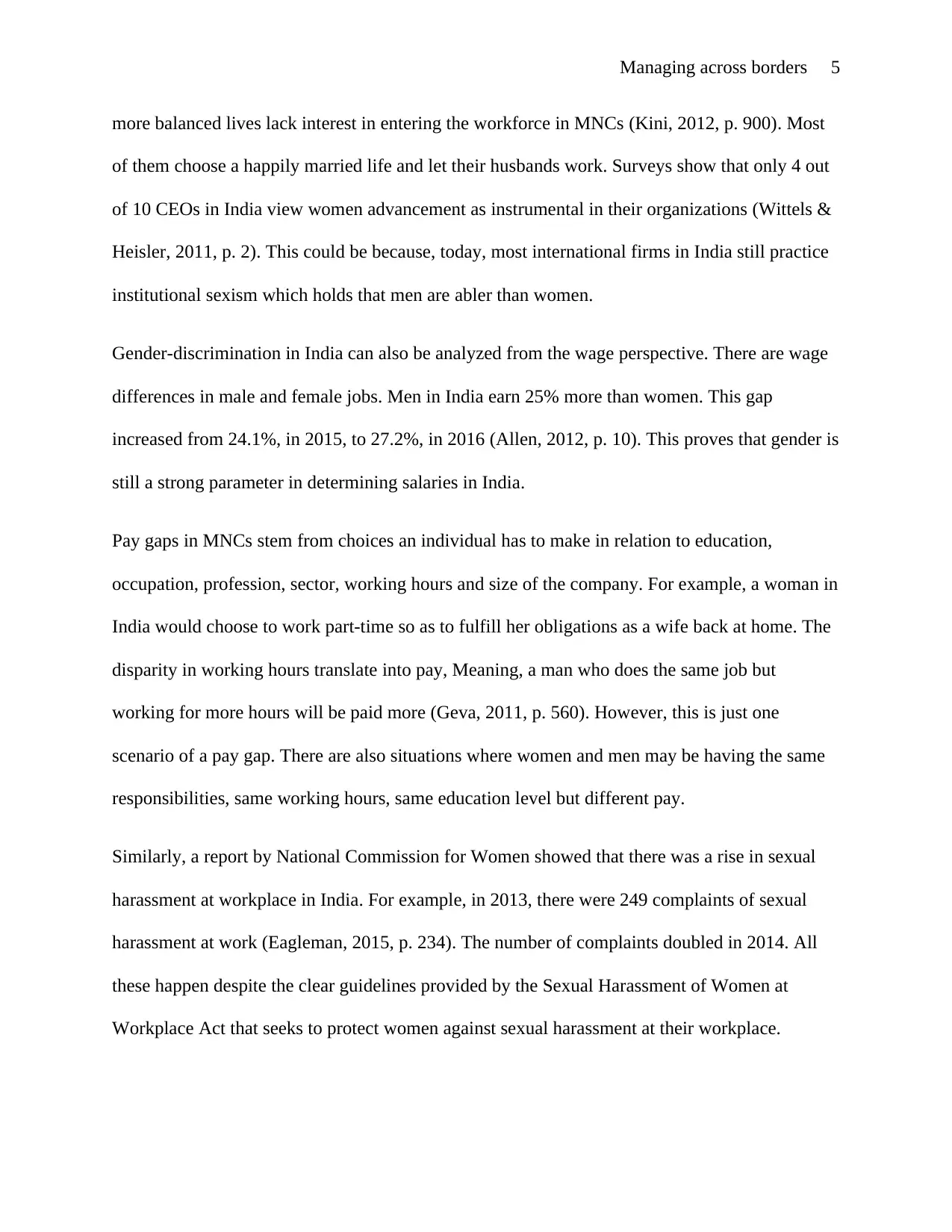
Managing across borders 5
more balanced lives lack interest in entering the workforce in MNCs (Kini, 2012, p. 900). Most
of them choose a happily married life and let their husbands work. Surveys show that only 4 out
of 10 CEOs in India view women advancement as instrumental in their organizations (Wittels &
Heisler, 2011, p. 2). This could be because, today, most international firms in India still practice
institutional sexism which holds that men are abler than women.
Gender-discrimination in India can also be analyzed from the wage perspective. There are wage
differences in male and female jobs. Men in India earn 25% more than women. This gap
increased from 24.1%, in 2015, to 27.2%, in 2016 (Allen, 2012, p. 10). This proves that gender is
still a strong parameter in determining salaries in India.
Pay gaps in MNCs stem from choices an individual has to make in relation to education,
occupation, profession, sector, working hours and size of the company. For example, a woman in
India would choose to work part-time so as to fulfill her obligations as a wife back at home. The
disparity in working hours translate into pay, Meaning, a man who does the same job but
working for more hours will be paid more (Geva, 2011, p. 560). However, this is just one
scenario of a pay gap. There are also situations where women and men may be having the same
responsibilities, same working hours, same education level but different pay.
Similarly, a report by National Commission for Women showed that there was a rise in sexual
harassment at workplace in India. For example, in 2013, there were 249 complaints of sexual
harassment at work (Eagleman, 2015, p. 234). The number of complaints doubled in 2014. All
these happen despite the clear guidelines provided by the Sexual Harassment of Women at
Workplace Act that seeks to protect women against sexual harassment at their workplace.
more balanced lives lack interest in entering the workforce in MNCs (Kini, 2012, p. 900). Most
of them choose a happily married life and let their husbands work. Surveys show that only 4 out
of 10 CEOs in India view women advancement as instrumental in their organizations (Wittels &
Heisler, 2011, p. 2). This could be because, today, most international firms in India still practice
institutional sexism which holds that men are abler than women.
Gender-discrimination in India can also be analyzed from the wage perspective. There are wage
differences in male and female jobs. Men in India earn 25% more than women. This gap
increased from 24.1%, in 2015, to 27.2%, in 2016 (Allen, 2012, p. 10). This proves that gender is
still a strong parameter in determining salaries in India.
Pay gaps in MNCs stem from choices an individual has to make in relation to education,
occupation, profession, sector, working hours and size of the company. For example, a woman in
India would choose to work part-time so as to fulfill her obligations as a wife back at home. The
disparity in working hours translate into pay, Meaning, a man who does the same job but
working for more hours will be paid more (Geva, 2011, p. 560). However, this is just one
scenario of a pay gap. There are also situations where women and men may be having the same
responsibilities, same working hours, same education level but different pay.
Similarly, a report by National Commission for Women showed that there was a rise in sexual
harassment at workplace in India. For example, in 2013, there were 249 complaints of sexual
harassment at work (Eagleman, 2015, p. 234). The number of complaints doubled in 2014. All
these happen despite the clear guidelines provided by the Sexual Harassment of Women at
Workplace Act that seeks to protect women against sexual harassment at their workplace.
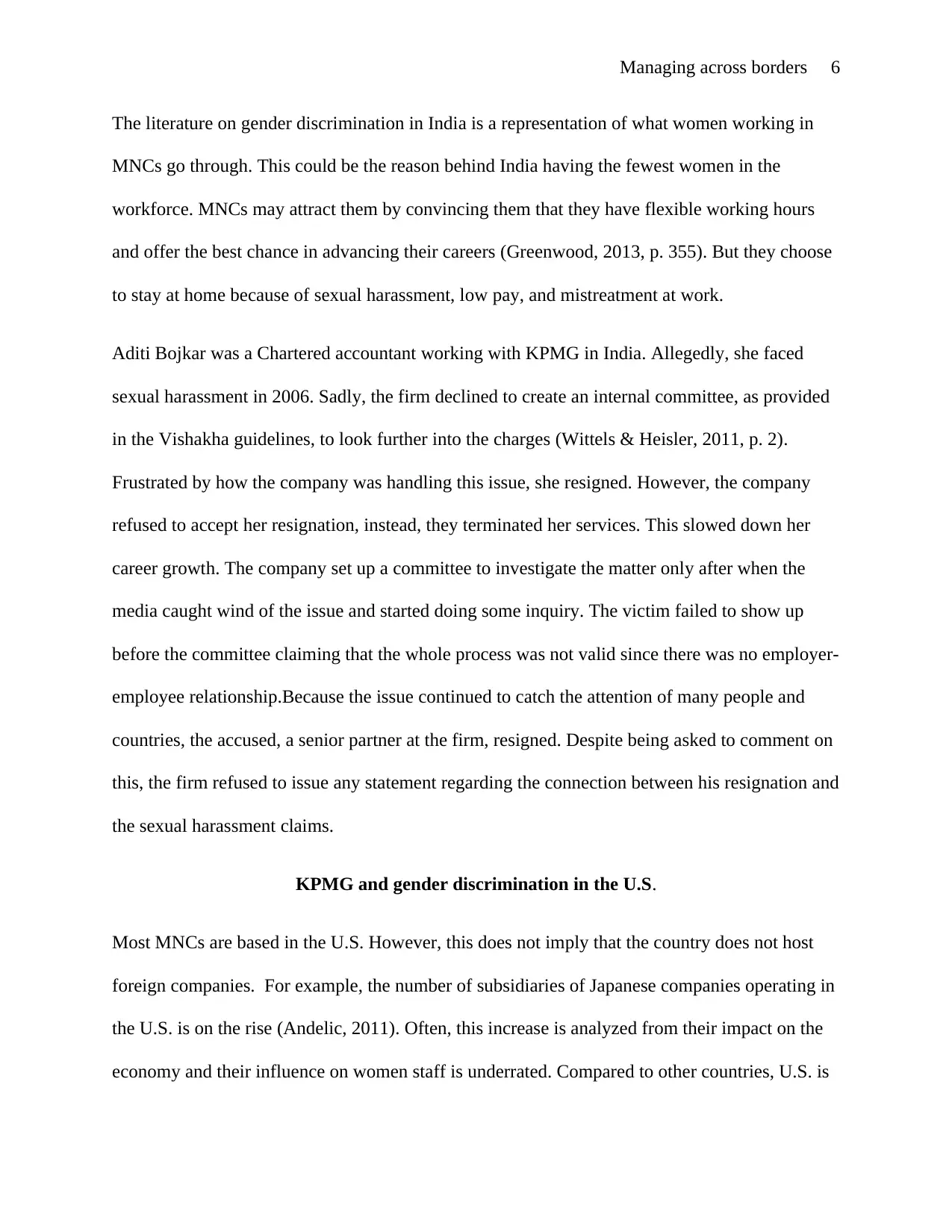
Managing across borders 6
The literature on gender discrimination in India is a representation of what women working in
MNCs go through. This could be the reason behind India having the fewest women in the
workforce. MNCs may attract them by convincing them that they have flexible working hours
and offer the best chance in advancing their careers (Greenwood, 2013, p. 355). But they choose
to stay at home because of sexual harassment, low pay, and mistreatment at work.
Aditi Bojkar was a Chartered accountant working with KPMG in India. Allegedly, she faced
sexual harassment in 2006. Sadly, the firm declined to create an internal committee, as provided
in the Vishakha guidelines, to look further into the charges (Wittels & Heisler, 2011, p. 2).
Frustrated by how the company was handling this issue, she resigned. However, the company
refused to accept her resignation, instead, they terminated her services. This slowed down her
career growth. The company set up a committee to investigate the matter only after when the
media caught wind of the issue and started doing some inquiry. The victim failed to show up
before the committee claiming that the whole process was not valid since there was no employer-
employee relationship.Because the issue continued to catch the attention of many people and
countries, the accused, a senior partner at the firm, resigned. Despite being asked to comment on
this, the firm refused to issue any statement regarding the connection between his resignation and
the sexual harassment claims.
KPMG and gender discrimination in the U.S.
Most MNCs are based in the U.S. However, this does not imply that the country does not host
foreign companies. For example, the number of subsidiaries of Japanese companies operating in
the U.S. is on the rise (Andelic, 2011). Often, this increase is analyzed from their impact on the
economy and their influence on women staff is underrated. Compared to other countries, U.S. is
The literature on gender discrimination in India is a representation of what women working in
MNCs go through. This could be the reason behind India having the fewest women in the
workforce. MNCs may attract them by convincing them that they have flexible working hours
and offer the best chance in advancing their careers (Greenwood, 2013, p. 355). But they choose
to stay at home because of sexual harassment, low pay, and mistreatment at work.
Aditi Bojkar was a Chartered accountant working with KPMG in India. Allegedly, she faced
sexual harassment in 2006. Sadly, the firm declined to create an internal committee, as provided
in the Vishakha guidelines, to look further into the charges (Wittels & Heisler, 2011, p. 2).
Frustrated by how the company was handling this issue, she resigned. However, the company
refused to accept her resignation, instead, they terminated her services. This slowed down her
career growth. The company set up a committee to investigate the matter only after when the
media caught wind of the issue and started doing some inquiry. The victim failed to show up
before the committee claiming that the whole process was not valid since there was no employer-
employee relationship.Because the issue continued to catch the attention of many people and
countries, the accused, a senior partner at the firm, resigned. Despite being asked to comment on
this, the firm refused to issue any statement regarding the connection between his resignation and
the sexual harassment claims.
KPMG and gender discrimination in the U.S.
Most MNCs are based in the U.S. However, this does not imply that the country does not host
foreign companies. For example, the number of subsidiaries of Japanese companies operating in
the U.S. is on the rise (Andelic, 2011). Often, this increase is analyzed from their impact on the
economy and their influence on women staff is underrated. Compared to other countries, U.S. is
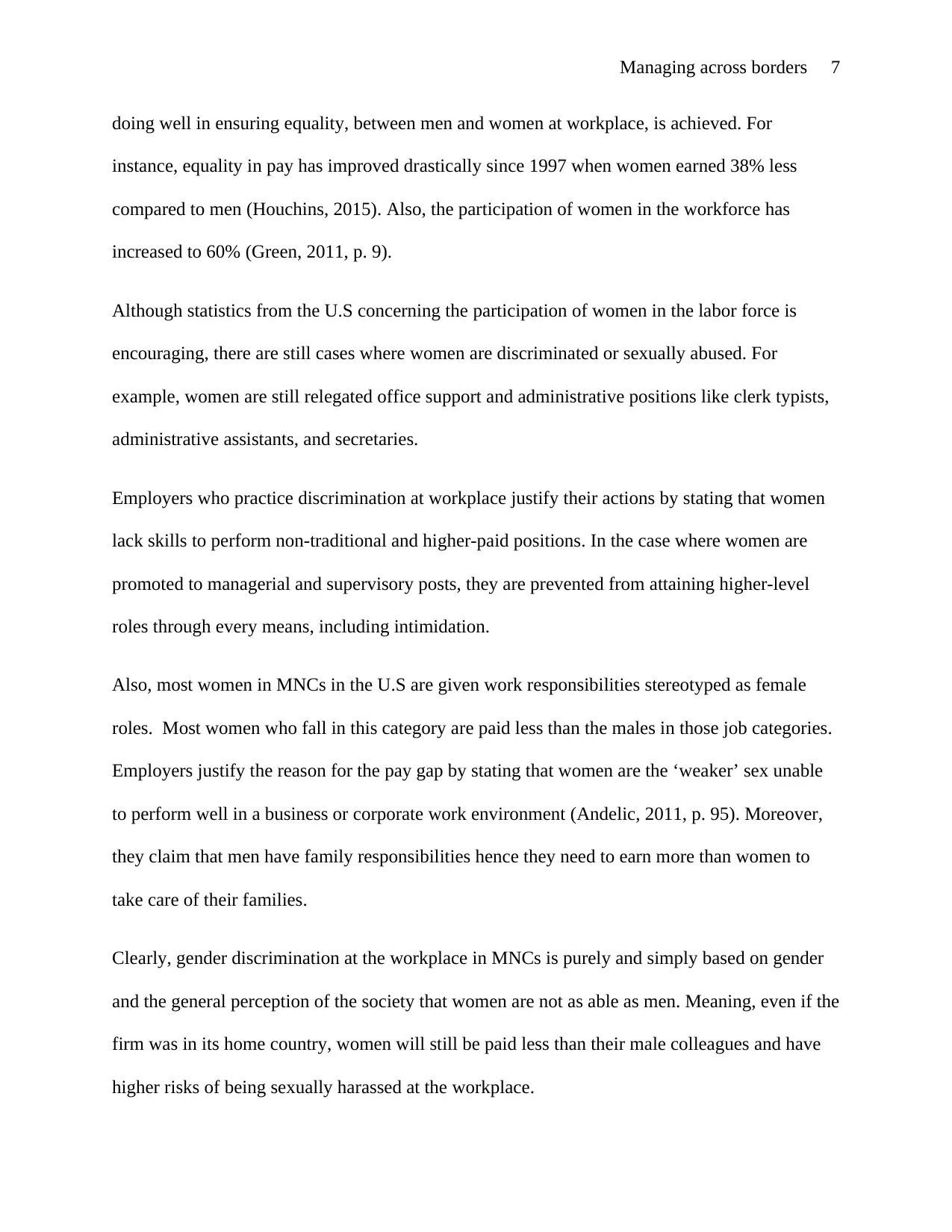
Managing across borders 7
doing well in ensuring equality, between men and women at workplace, is achieved. For
instance, equality in pay has improved drastically since 1997 when women earned 38% less
compared to men (Houchins, 2015). Also, the participation of women in the workforce has
increased to 60% (Green, 2011, p. 9).
Although statistics from the U.S concerning the participation of women in the labor force is
encouraging, there are still cases where women are discriminated or sexually abused. For
example, women are still relegated office support and administrative positions like clerk typists,
administrative assistants, and secretaries.
Employers who practice discrimination at workplace justify their actions by stating that women
lack skills to perform non-traditional and higher-paid positions. In the case where women are
promoted to managerial and supervisory posts, they are prevented from attaining higher-level
roles through every means, including intimidation.
Also, most women in MNCs in the U.S are given work responsibilities stereotyped as female
roles. Most women who fall in this category are paid less than the males in those job categories.
Employers justify the reason for the pay gap by stating that women are the ‘weaker’ sex unable
to perform well in a business or corporate work environment (Andelic, 2011, p. 95). Moreover,
they claim that men have family responsibilities hence they need to earn more than women to
take care of their families.
Clearly, gender discrimination at the workplace in MNCs is purely and simply based on gender
and the general perception of the society that women are not as able as men. Meaning, even if the
firm was in its home country, women will still be paid less than their male colleagues and have
higher risks of being sexually harassed at the workplace.
doing well in ensuring equality, between men and women at workplace, is achieved. For
instance, equality in pay has improved drastically since 1997 when women earned 38% less
compared to men (Houchins, 2015). Also, the participation of women in the workforce has
increased to 60% (Green, 2011, p. 9).
Although statistics from the U.S concerning the participation of women in the labor force is
encouraging, there are still cases where women are discriminated or sexually abused. For
example, women are still relegated office support and administrative positions like clerk typists,
administrative assistants, and secretaries.
Employers who practice discrimination at workplace justify their actions by stating that women
lack skills to perform non-traditional and higher-paid positions. In the case where women are
promoted to managerial and supervisory posts, they are prevented from attaining higher-level
roles through every means, including intimidation.
Also, most women in MNCs in the U.S are given work responsibilities stereotyped as female
roles. Most women who fall in this category are paid less than the males in those job categories.
Employers justify the reason for the pay gap by stating that women are the ‘weaker’ sex unable
to perform well in a business or corporate work environment (Andelic, 2011, p. 95). Moreover,
they claim that men have family responsibilities hence they need to earn more than women to
take care of their families.
Clearly, gender discrimination at the workplace in MNCs is purely and simply based on gender
and the general perception of the society that women are not as able as men. Meaning, even if the
firm was in its home country, women will still be paid less than their male colleagues and have
higher risks of being sexually harassed at the workplace.
Paraphrase This Document
Need a fresh take? Get an instant paraphrase of this document with our AI Paraphraser

Managing across borders 8
Donna Kassman, a former female senior manager filed a 350 million dollar class action
discrimination lawsuit against KPMG in the U.S.,District Court for the Southern District of New
York, 2011. She resigned from the company, after seventeen years, because of gender
discrimination (Wittels & Heisler, 2011, p. 3). She claimed that the company engages in
systematic discrimination against its female managers,-senior managers and managing directors.
The plaintiff said that the lawsuit was directed towards ending systematic gender discrimination
at the company; discriminatory pay, promotion practices and policies, and failure to investigate
and resolve discrimination and harassment complaints.
In her statement, Kassman claimed that KMPG refused to promote her. Her supervisor
repeatedly gave her false hopes that she was next in line to be promoted between 2008 and 2009
(Wittels & Heisler, 2011, p. 3). It is also during the same period that two of her male colleagues
complained that she was unapproachable. These claims drastically derailed her career
advancement. She was advised to meet with a specialist to advise her on how she could work on
her issues and the two male colleagues who forwarded complaints against Kassman were
promoted (Wittels & Heisler, 2011, p. 3).
Kassman also recalled when her base salary was cut down by $20,000 when she was on
maternity leave. The company gave no reasons for slashing her salary. When she enquired
further, her supervisor told her that she did not need that amount because she had a nice
engagement ring. This shows how KPMG tolerates and perpetuates gender discrimination. In
October.2010, Kassman resigned because she could no longer tolerate the discrimination and
harassment anymore (Wittels & Heisler, 2011, p. 3). Plus, it was so clear that KPMG had no
intentions of addressing the situation.
Donna Kassman, a former female senior manager filed a 350 million dollar class action
discrimination lawsuit against KPMG in the U.S.,District Court for the Southern District of New
York, 2011. She resigned from the company, after seventeen years, because of gender
discrimination (Wittels & Heisler, 2011, p. 3). She claimed that the company engages in
systematic discrimination against its female managers,-senior managers and managing directors.
The plaintiff said that the lawsuit was directed towards ending systematic gender discrimination
at the company; discriminatory pay, promotion practices and policies, and failure to investigate
and resolve discrimination and harassment complaints.
In her statement, Kassman claimed that KMPG refused to promote her. Her supervisor
repeatedly gave her false hopes that she was next in line to be promoted between 2008 and 2009
(Wittels & Heisler, 2011, p. 3). It is also during the same period that two of her male colleagues
complained that she was unapproachable. These claims drastically derailed her career
advancement. She was advised to meet with a specialist to advise her on how she could work on
her issues and the two male colleagues who forwarded complaints against Kassman were
promoted (Wittels & Heisler, 2011, p. 3).
Kassman also recalled when her base salary was cut down by $20,000 when she was on
maternity leave. The company gave no reasons for slashing her salary. When she enquired
further, her supervisor told her that she did not need that amount because she had a nice
engagement ring. This shows how KPMG tolerates and perpetuates gender discrimination. In
October.2010, Kassman resigned because she could no longer tolerate the discrimination and
harassment anymore (Wittels & Heisler, 2011, p. 3). Plus, it was so clear that KPMG had no
intentions of addressing the situation.
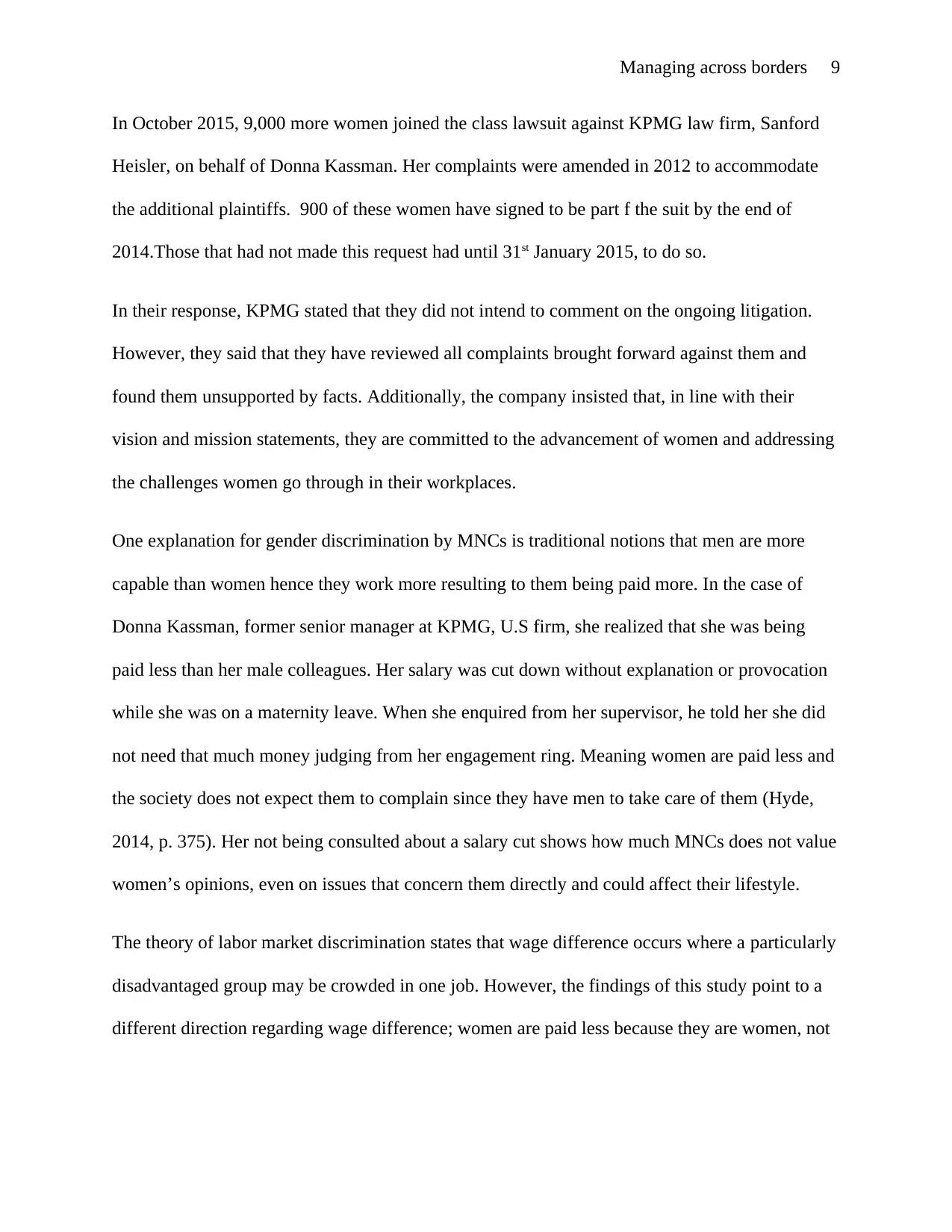
Managing across borders 9
In October 2015, 9,000 more women joined the class lawsuit against KPMG law firm, Sanford
Heisler, on behalf of Donna Kassman. Her complaints were amended in 2012 to accommodate
the additional plaintiffs. 900 of these women have signed to be part f the suit by the end of
2014.Those that had not made this request had until 31st January 2015, to do so.
In their response, KPMG stated that they did not intend to comment on the ongoing litigation.
However, they said that they have reviewed all complaints brought forward against them and
found them unsupported by facts. Additionally, the company insisted that, in line with their
vision and mission statements, they are committed to the advancement of women and addressing
the challenges women go through in their workplaces.
One explanation for gender discrimination by MNCs is traditional notions that men are more
capable than women hence they work more resulting to them being paid more. In the case of
Donna Kassman, former senior manager at KPMG, U.S firm, she realized that she was being
paid less than her male colleagues. Her salary was cut down without explanation or provocation
while she was on a maternity leave. When she enquired from her supervisor, he told her she did
not need that much money judging from her engagement ring. Meaning women are paid less and
the society does not expect them to complain since they have men to take care of them (Hyde,
2014, p. 375). Her not being consulted about a salary cut shows how much MNCs does not value
women’s opinions, even on issues that concern them directly and could affect their lifestyle.
The theory of labor market discrimination states that wage difference occurs where a particularly
disadvantaged group may be crowded in one job. However, the findings of this study point to a
different direction regarding wage difference; women are paid less because they are women, not
In October 2015, 9,000 more women joined the class lawsuit against KPMG law firm, Sanford
Heisler, on behalf of Donna Kassman. Her complaints were amended in 2012 to accommodate
the additional plaintiffs. 900 of these women have signed to be part f the suit by the end of
2014.Those that had not made this request had until 31st January 2015, to do so.
In their response, KPMG stated that they did not intend to comment on the ongoing litigation.
However, they said that they have reviewed all complaints brought forward against them and
found them unsupported by facts. Additionally, the company insisted that, in line with their
vision and mission statements, they are committed to the advancement of women and addressing
the challenges women go through in their workplaces.
One explanation for gender discrimination by MNCs is traditional notions that men are more
capable than women hence they work more resulting to them being paid more. In the case of
Donna Kassman, former senior manager at KPMG, U.S firm, she realized that she was being
paid less than her male colleagues. Her salary was cut down without explanation or provocation
while she was on a maternity leave. When she enquired from her supervisor, he told her she did
not need that much money judging from her engagement ring. Meaning women are paid less and
the society does not expect them to complain since they have men to take care of them (Hyde,
2014, p. 375). Her not being consulted about a salary cut shows how much MNCs does not value
women’s opinions, even on issues that concern them directly and could affect their lifestyle.
The theory of labor market discrimination states that wage difference occurs where a particularly
disadvantaged group may be crowded in one job. However, the findings of this study point to a
different direction regarding wage difference; women are paid less because they are women, not
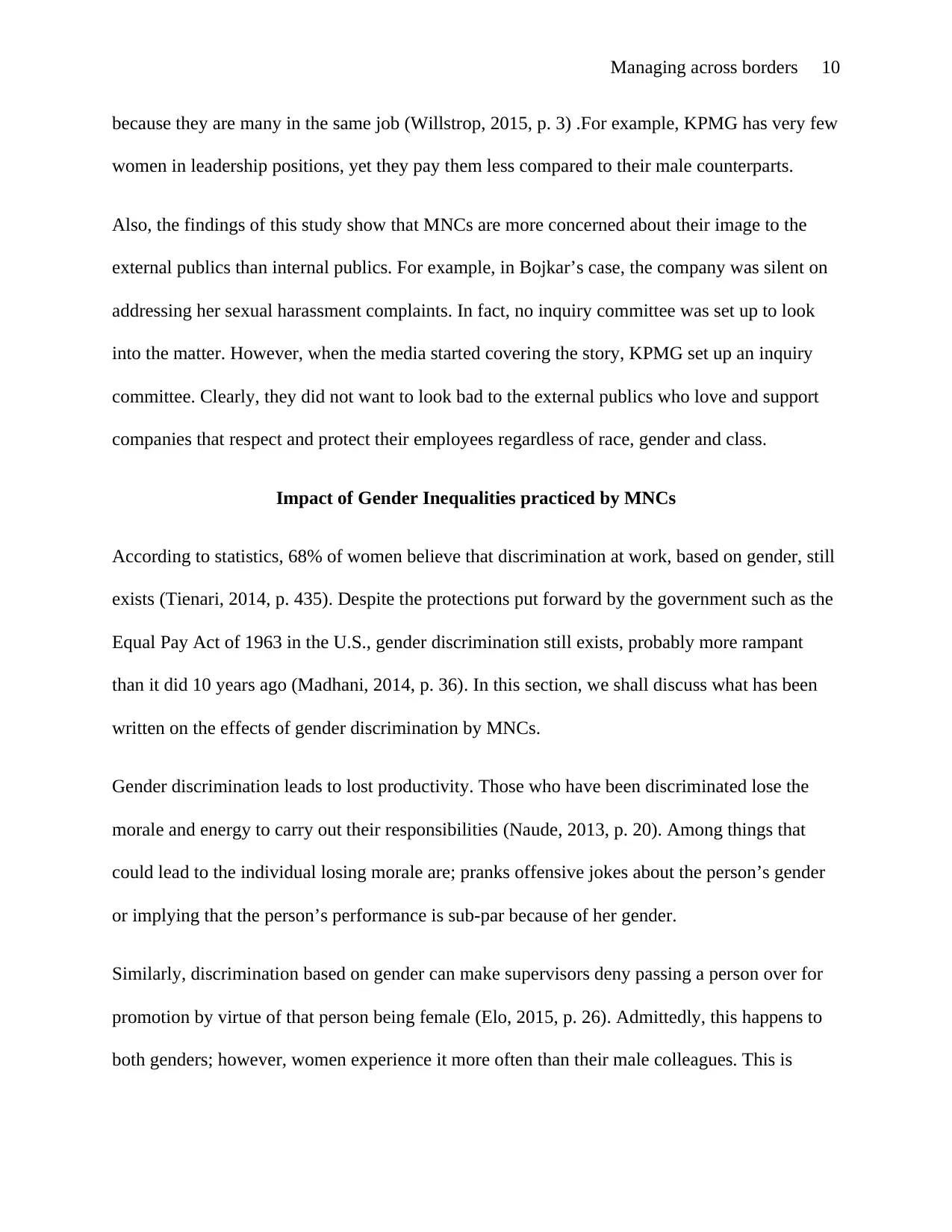
Managing across borders 10
because they are many in the same job (Willstrop, 2015, p. 3) .For example, KPMG has very few
women in leadership positions, yet they pay them less compared to their male counterparts.
Also, the findings of this study show that MNCs are more concerned about their image to the
external publics than internal publics. For example, in Bojkar’s case, the company was silent on
addressing her sexual harassment complaints. In fact, no inquiry committee was set up to look
into the matter. However, when the media started covering the story, KPMG set up an inquiry
committee. Clearly, they did not want to look bad to the external publics who love and support
companies that respect and protect their employees regardless of race, gender and class.
Impact of Gender Inequalities practiced by MNCs
According to statistics, 68% of women believe that discrimination at work, based on gender, still
exists (Tienari, 2014, p. 435). Despite the protections put forward by the government such as the
Equal Pay Act of 1963 in the U.S., gender discrimination still exists, probably more rampant
than it did 10 years ago (Madhani, 2014, p. 36). In this section, we shall discuss what has been
written on the effects of gender discrimination by MNCs.
Gender discrimination leads to lost productivity. Those who have been discriminated lose the
morale and energy to carry out their responsibilities (Naude, 2013, p. 20). Among things that
could lead to the individual losing morale are; pranks offensive jokes about the person’s gender
or implying that the person’s performance is sub-par because of her gender.
Similarly, discrimination based on gender can make supervisors deny passing a person over for
promotion by virtue of that person being female (Elo, 2015, p. 26). Admittedly, this happens to
both genders; however, women experience it more often than their male colleagues. This is
because they are many in the same job (Willstrop, 2015, p. 3) .For example, KPMG has very few
women in leadership positions, yet they pay them less compared to their male counterparts.
Also, the findings of this study show that MNCs are more concerned about their image to the
external publics than internal publics. For example, in Bojkar’s case, the company was silent on
addressing her sexual harassment complaints. In fact, no inquiry committee was set up to look
into the matter. However, when the media started covering the story, KPMG set up an inquiry
committee. Clearly, they did not want to look bad to the external publics who love and support
companies that respect and protect their employees regardless of race, gender and class.
Impact of Gender Inequalities practiced by MNCs
According to statistics, 68% of women believe that discrimination at work, based on gender, still
exists (Tienari, 2014, p. 435). Despite the protections put forward by the government such as the
Equal Pay Act of 1963 in the U.S., gender discrimination still exists, probably more rampant
than it did 10 years ago (Madhani, 2014, p. 36). In this section, we shall discuss what has been
written on the effects of gender discrimination by MNCs.
Gender discrimination leads to lost productivity. Those who have been discriminated lose the
morale and energy to carry out their responsibilities (Naude, 2013, p. 20). Among things that
could lead to the individual losing morale are; pranks offensive jokes about the person’s gender
or implying that the person’s performance is sub-par because of her gender.
Similarly, discrimination based on gender can make supervisors deny passing a person over for
promotion by virtue of that person being female (Elo, 2015, p. 26). Admittedly, this happens to
both genders; however, women experience it more often than their male colleagues. This is
Secure Best Marks with AI Grader
Need help grading? Try our AI Grader for instant feedback on your assignments.
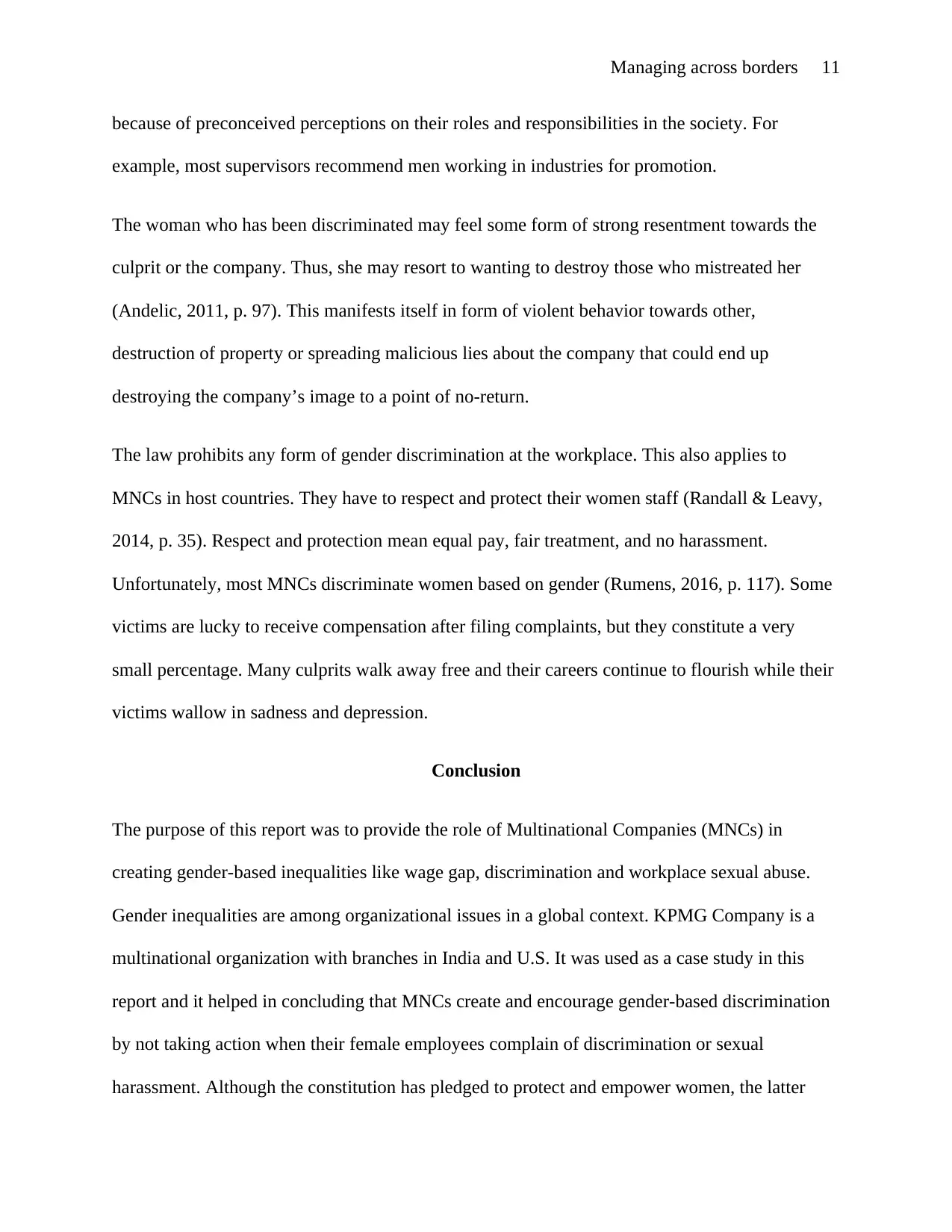
Managing across borders 11
because of preconceived perceptions on their roles and responsibilities in the society. For
example, most supervisors recommend men working in industries for promotion.
The woman who has been discriminated may feel some form of strong resentment towards the
culprit or the company. Thus, she may resort to wanting to destroy those who mistreated her
(Andelic, 2011, p. 97). This manifests itself in form of violent behavior towards other,
destruction of property or spreading malicious lies about the company that could end up
destroying the company’s image to a point of no-return.
The law prohibits any form of gender discrimination at the workplace. This also applies to
MNCs in host countries. They have to respect and protect their women staff (Randall & Leavy,
2014, p. 35). Respect and protection mean equal pay, fair treatment, and no harassment.
Unfortunately, most MNCs discriminate women based on gender (Rumens, 2016, p. 117). Some
victims are lucky to receive compensation after filing complaints, but they constitute a very
small percentage. Many culprits walk away free and their careers continue to flourish while their
victims wallow in sadness and depression.
Conclusion
The purpose of this report was to provide the role of Multinational Companies (MNCs) in
creating gender-based inequalities like wage gap, discrimination and workplace sexual abuse.
Gender inequalities are among organizational issues in a global context. KPMG Company is a
multinational organization with branches in India and U.S. It was used as a case study in this
report and it helped in concluding that MNCs create and encourage gender-based discrimination
by not taking action when their female employees complain of discrimination or sexual
harassment. Although the constitution has pledged to protect and empower women, the latter
because of preconceived perceptions on their roles and responsibilities in the society. For
example, most supervisors recommend men working in industries for promotion.
The woman who has been discriminated may feel some form of strong resentment towards the
culprit or the company. Thus, she may resort to wanting to destroy those who mistreated her
(Andelic, 2011, p. 97). This manifests itself in form of violent behavior towards other,
destruction of property or spreading malicious lies about the company that could end up
destroying the company’s image to a point of no-return.
The law prohibits any form of gender discrimination at the workplace. This also applies to
MNCs in host countries. They have to respect and protect their women staff (Randall & Leavy,
2014, p. 35). Respect and protection mean equal pay, fair treatment, and no harassment.
Unfortunately, most MNCs discriminate women based on gender (Rumens, 2016, p. 117). Some
victims are lucky to receive compensation after filing complaints, but they constitute a very
small percentage. Many culprits walk away free and their careers continue to flourish while their
victims wallow in sadness and depression.
Conclusion
The purpose of this report was to provide the role of Multinational Companies (MNCs) in
creating gender-based inequalities like wage gap, discrimination and workplace sexual abuse.
Gender inequalities are among organizational issues in a global context. KPMG Company is a
multinational organization with branches in India and U.S. It was used as a case study in this
report and it helped in concluding that MNCs create and encourage gender-based discrimination
by not taking action when their female employees complain of discrimination or sexual
harassment. Although the constitution has pledged to protect and empower women, the latter
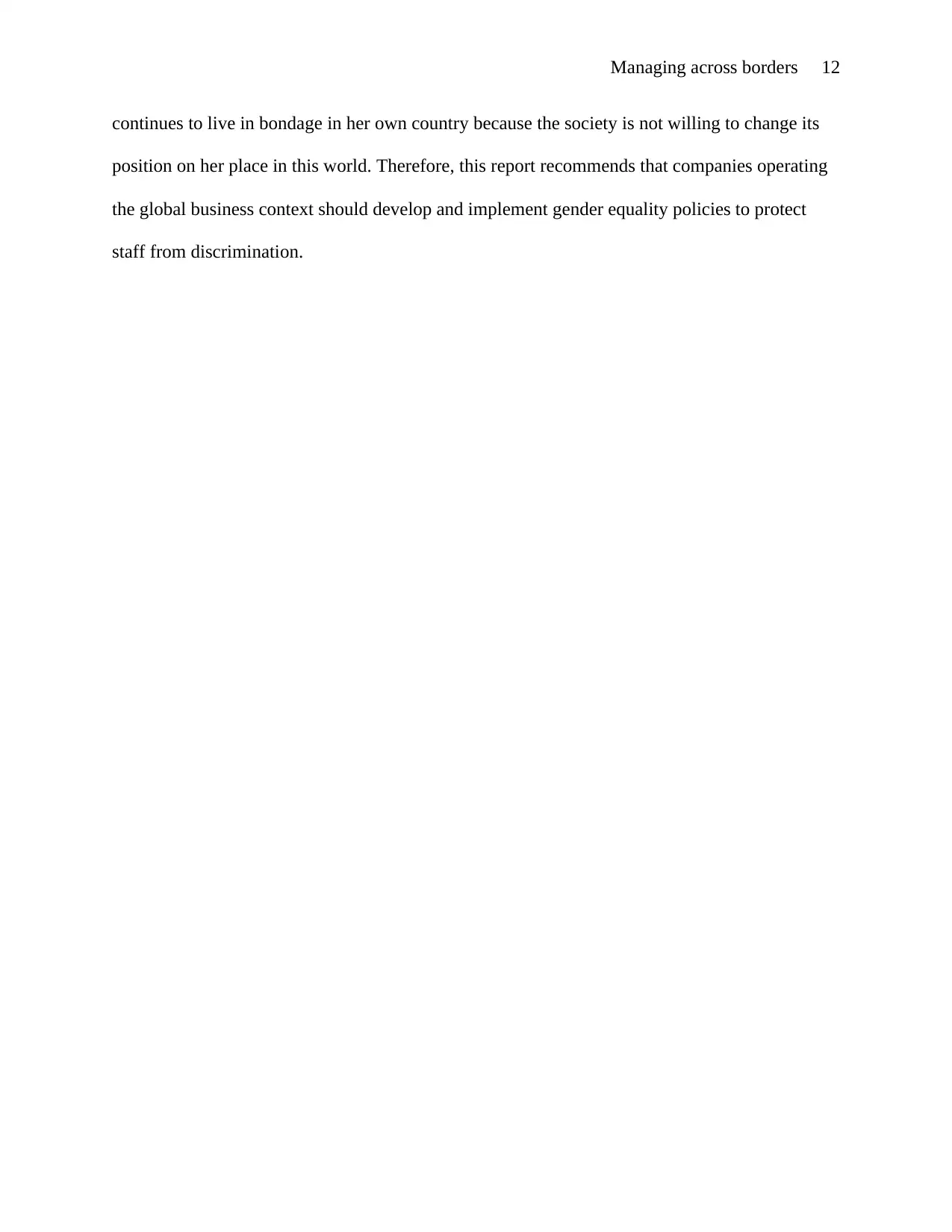
Managing across borders 12
continues to live in bondage in her own country because the society is not willing to change its
position on her place in this world. Therefore, this report recommends that companies operating
the global business context should develop and implement gender equality policies to protect
staff from discrimination.
continues to live in bondage in her own country because the society is not willing to change its
position on her place in this world. Therefore, this report recommends that companies operating
the global business context should develop and implement gender equality policies to protect
staff from discrimination.

Managing across borders 13
References List
Adityanath, Y., 2015. Most Indian Companies and MNCs not Compliant with the Sexual Harassment Act.
[Online]
Available at: http://www.dnaindia.com
[Accessed 21 March 2017].
Allen, R. C., 2012. Technology and the great divergence : Global economic development since 1820.
Journal of Economic History, pp. 1-16.
Andelic, G., 2011. The impact of Globalization on the Insurance and Reinsurance Market of Eastern
Europe. South East European Journal of Economics and Business, pp. 95-112.
Baron, J. N., 2013. Empathy wages?: Gratitude and gift exchange in employment relationships. Journal
metrics, pp. 24-30.
Eagleman, A., 2015. Constructing gender differences: Newspaper portrayals of male and female
gymnasts at the 2012 Olympic Games. Sport in Society, pp. 234-247.
Elo, M., 2015. Diaspora Networks in International business: A review of emerging stream research.
Handbook on International Alliance and Network Research, pp. 13-40.
Geva, D., 2011. Different and Unequal? Breadwinning, Dependency Deferments, and the Gendered
Origins of the US Selective Service System. Armed Forces & Society, pp. 598-618.
Green, J., 2011. How Does Globalization Affect an Organization's Business Approach?. Small
Business.chron, pp. 8-12.
Greenwood, M., 2013. Ethical analyses of HRM: A review and research agenda. Journal of Business
Ethics, pp. 355-366.
Houchins, M., 2015. This Day in History: Equal Pay Trailblazer Lilly Ledbetter Turns 77. [Online]
Available at: http://www.whitehouse.gov
[Accessed 7 October 2016].
Hyde, J. S., 2014. Gender Similarities and differences. Annual Review of Psychology, pp. 373-398.
Kini, D., 2012. Materials management: The key to successful project management. Journal of
Management in Engineering, pp. 865-876.
Madhani, P. M., 2014. Corporate governance of Indian firms: An Industry Perspective. International
Business Review, pp. 34-50.
Naude', W., 2013. Entrepreneurship and economic development: Theory of evidence and policy.
Browser Download This Paper, pp. 15-43.
References List
Adityanath, Y., 2015. Most Indian Companies and MNCs not Compliant with the Sexual Harassment Act.
[Online]
Available at: http://www.dnaindia.com
[Accessed 21 March 2017].
Allen, R. C., 2012. Technology and the great divergence : Global economic development since 1820.
Journal of Economic History, pp. 1-16.
Andelic, G., 2011. The impact of Globalization on the Insurance and Reinsurance Market of Eastern
Europe. South East European Journal of Economics and Business, pp. 95-112.
Baron, J. N., 2013. Empathy wages?: Gratitude and gift exchange in employment relationships. Journal
metrics, pp. 24-30.
Eagleman, A., 2015. Constructing gender differences: Newspaper portrayals of male and female
gymnasts at the 2012 Olympic Games. Sport in Society, pp. 234-247.
Elo, M., 2015. Diaspora Networks in International business: A review of emerging stream research.
Handbook on International Alliance and Network Research, pp. 13-40.
Geva, D., 2011. Different and Unequal? Breadwinning, Dependency Deferments, and the Gendered
Origins of the US Selective Service System. Armed Forces & Society, pp. 598-618.
Green, J., 2011. How Does Globalization Affect an Organization's Business Approach?. Small
Business.chron, pp. 8-12.
Greenwood, M., 2013. Ethical analyses of HRM: A review and research agenda. Journal of Business
Ethics, pp. 355-366.
Houchins, M., 2015. This Day in History: Equal Pay Trailblazer Lilly Ledbetter Turns 77. [Online]
Available at: http://www.whitehouse.gov
[Accessed 7 October 2016].
Hyde, J. S., 2014. Gender Similarities and differences. Annual Review of Psychology, pp. 373-398.
Kini, D., 2012. Materials management: The key to successful project management. Journal of
Management in Engineering, pp. 865-876.
Madhani, P. M., 2014. Corporate governance of Indian firms: An Industry Perspective. International
Business Review, pp. 34-50.
Naude', W., 2013. Entrepreneurship and economic development: Theory of evidence and policy.
Browser Download This Paper, pp. 15-43.
Paraphrase This Document
Need a fresh take? Get an instant paraphrase of this document with our AI Paraphraser

Managing across borders 14
Nielsen, W. M., 2016. Gender inequality and research performance: Moving beyond individual-
meritocratic explanations of academic advancement. Studies in Higher Education, pp. 2044-2060.
Randall, R. & Leavy, B., 2014. India: MNC Strategies for growth and Innovation. Strategy & Leadership,
pp. 30-39.
Rumens, N., 2016. Sexualities and accounting: A queer theory perspective. Critical Perspectives on
Accounting 35, pp. 111-120.
Tienari, J., 2014. 17. no gender, please, we're international management scholars!. Research Handbook
on women in International management, pp. 435-439.
Willstrop, J., 2015. The Long and Slow Journey towards equal pay and attention for women's sports.
[Online]
Available at: http://www.theguardian.com
[Accessed 12 October 2016].
Wittels, S. & Heisler, L., 2011. Accounting Giant KPMG LLP Faces $350 Million Gender Discrimination
Class Action. [Online]
Available at: http://www.prnewswire.com
[Accessed 21 March 2017].
Nielsen, W. M., 2016. Gender inequality and research performance: Moving beyond individual-
meritocratic explanations of academic advancement. Studies in Higher Education, pp. 2044-2060.
Randall, R. & Leavy, B., 2014. India: MNC Strategies for growth and Innovation. Strategy & Leadership,
pp. 30-39.
Rumens, N., 2016. Sexualities and accounting: A queer theory perspective. Critical Perspectives on
Accounting 35, pp. 111-120.
Tienari, J., 2014. 17. no gender, please, we're international management scholars!. Research Handbook
on women in International management, pp. 435-439.
Willstrop, J., 2015. The Long and Slow Journey towards equal pay and attention for women's sports.
[Online]
Available at: http://www.theguardian.com
[Accessed 12 October 2016].
Wittels, S. & Heisler, L., 2011. Accounting Giant KPMG LLP Faces $350 Million Gender Discrimination
Class Action. [Online]
Available at: http://www.prnewswire.com
[Accessed 21 March 2017].
1 out of 14
Related Documents
Your All-in-One AI-Powered Toolkit for Academic Success.
+13062052269
info@desklib.com
Available 24*7 on WhatsApp / Email
![[object Object]](/_next/static/media/star-bottom.7253800d.svg)
Unlock your academic potential
© 2024 | Zucol Services PVT LTD | All rights reserved.





